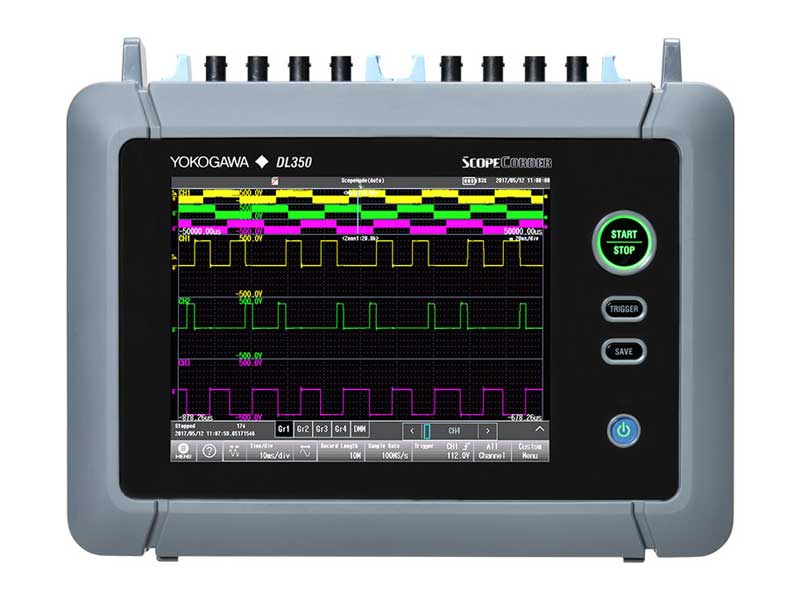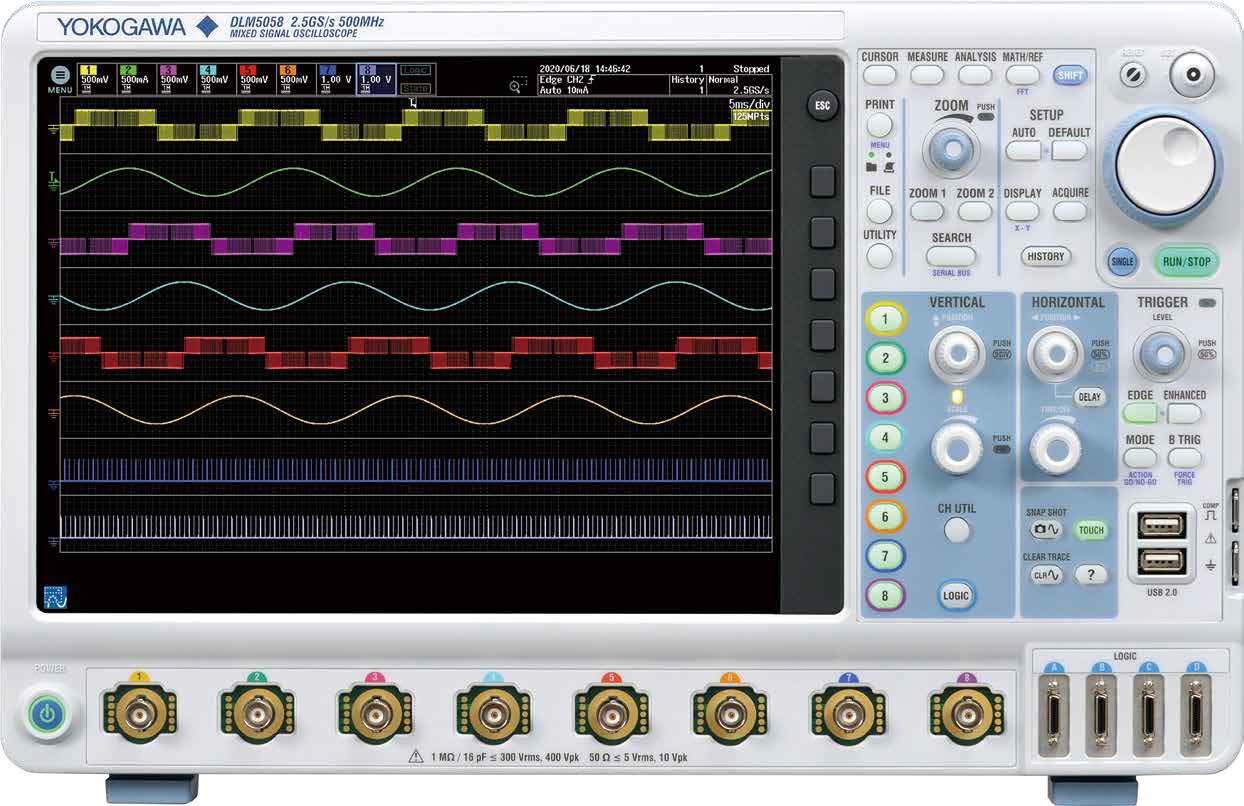Choosing the Right Instrument for Power Quality and Energy Efficiency - Power Compliance, Efficiency, and Harmonics Tests
Introduction
More than 40 percent of the total energy consumed in the United States is used to operate buildings, and most of that is consumed by appliances and building-related equipment. The U.S. Department of Energy (DOE) implements minimum efficiency standards for a wide range of appliances and equipment used in residential and commercial buildings. Currently, DOE efficiency standards cover more than 60 categories of products.
With increased focus on reducing energy consumption and compliance with efficiency standards, the following provides an overview on the types of measurements needed for efficiency and power quality and the instruments that take them.
The Background
Power quality, power efficiency, and power compliance are terms often used interchangeably, but actually have different meanings depending on the industry being referenced.
The three variables to consider when choosing the best instrument for power compliance and power quality measurements are measurement type, measurement standard, and instrument type.
This application note defines these variables and provides guidance along a clear path to making the most accurate power quality, efficiency, or compliance measurement.
Measurement Types
The measurements in Table 1 comprise a good generalization of typical measurement types that span various applications and industries.

Table 1. Measurements used to quantify power quality and efficiency.
Measurement Standard
While the number of power standards is in the hundreds, those listed in Table 2 represent the more common requirements. The standards are often specific to an industry, though some span a few, in which case the test criteria can be similar.

Table 2. Industry standards require specific measurements.
Instrument Type
There are a variety of instruments on the market that can potentially meet power efficiency and power quality measurement needs. Depending on the circumstances, one may need the waveform analysis of an oscilloscope, the high accuracy of a power analyzer, or a hybrid combination of the two with the flexibility of data acquisition added into the mix. For more details on instrument types and other considerations and functionality, recommended reading is the Yokogawa Test&Measurement white paper Choosing the Right Power Measurement Instrument.
The measurements in Table 1 can be made on various power measurement instruments. Table 3 illustrates the best instrument for each measurement type.

Table 3. Measurement types need to be considered when choosing an ideal instrument type. There is rarely one instrument that is ideal for all measurements.
What makes one instrument better suited to a measurement than another? It depends on the specific measurement(s) required per the standard test specifications.
Measurements are divided into three categories: energy, power quality, and transient capture.
Energy
Energy is often expressed in units of Watt-hours (Wh) and is best measured by a power analyzer due to the streaming nature of the acquisition system to measure power over time. Oscilloscopes cannot stream continuously and are ideal for transient capture. For more information on the energy measurements of a power analyzer, please refer to the Yokogawa Test&Measurement white paper Fundamentals of Electric Power Measurements.
Power Quality
Power quality is a measure of the deviation from the normal sine wave from which the power source was generated. Poor power quality manifests itself through various phenomena. The measure of the phenomena listed in Table 3 can help one understand potential issues with power systems and provide insight into mitigation issues. Although these measurements are transient in nature, some tests require the precision of a power analyzer. For those reasons, either a power analyzer or power scope would be recommended.
Transient Capture
Transients are short-lived and often occur only once in a sequence. Oscilloscopes are purpose-built for transient capture due to their high bandwidth, high sample rates, complex triggering, and measurement gating capabilities. The best instrument types for this measurement category are the oscilloscope and the power scope. The trade-off of accuracy of the power scope versus the bandwidth / sampling rate of the oscilloscope needs to be explored further.
Measurement Accuracy
Since every measurement device is characterized by some degree of uncertainty, accuracy is normally expressed as a range. Within the range, engineers consider power accuracy as the primary indicator of uncertainty for basic measurement parameters such as voltage, current, phase angle, and power. These parameters may be presented using terms such as “guaranteed accuracy” and “typical accuracy.” To learn more, please refer to the Yokogawa Test&Measurement white paper Accuracy Specifications: Reading it Right with Range.
There are many types of accuracy, including AC, DC, and harmonic. Table 4 helps guide the instrument selection process based on individual needs.

Table 4. Power analyzers and power scopes are the only instruments that guarantee AC accuracy.
Guaranteed vs. Typical
What does “typical” mean in this context, in terms of Watts? The term is often misleading. A typical value is usually a reference value based on a manufacturer’s expectation from its product. In practice, it can be translated as “usually but not always,” “maybe,” “perhaps,” or “possibly.” It is deliberately vague because typical accuracies are neither guaranteed nor traceable to a national calibration standard or accredited calibration laboratory standard. When selecting a power measurement instrument, the prospective user should be sure that the published accuracies are guaranteed values rather than typical values.
AC Accuracy
In power measurement, not enough emphasis is placed on AC accuracy. Often, instruments will guarantee AC accuracy at 50-60 Hz, but more power applications measure signal content outside the 50-60 Hz range due to fundamental frequencies changing per application, and harmonic content at multiples of those frequencies. The ideal instrument will have AC accuracy specified through the entire bandwidth range.
Harmonic Accuracy
Harmonic accuracy is important for testing to standards that require specific harmonic orders. An order pertains to the specific multiple of the fundamental. An instrument that specifies harmonic accuracy provides assurances that measured values are guaranteed.
Analog-to-Digital Converter (ADC) Resolution
In measurement terms, resolution is the smallest increment that the instrument can indicate or display. The more resolution an instrument has, the more it can resolve differences or details on waveforms. It is commonly expressed as the number of bits. The number of bits is often specified by the ADC manufacturer, but noise and distortion will reduce the actual resolution of the instrument. To account for this, instrument manufacturers use effective number of bits (ENOB) or signal plus noise and distortion (SINAD) to represent the resolution of the instrument. Filters or techniques such as averaging can improve resolution as well, but come at a trade-off. A power analyzer provides the greatest resolution among measurement instruments at 18 bits, followed by the power scope at 12 bits. Oscilloscopes have a resolution between eight and 12 bits. When measurements require the best accuracy, a power analyzer is recommended.
The Solution
Power quality issues will continue to be prevalent in modern electrical systems due to the rising use of non-linear devices to control power. Due to the detrimental effects on motors, transformers, switch gear, fuses, and other devices, it is becoming more important to accurately measure and quantify harmonic orders to not only determine compliance with systems and standards, but to assist in the mitigation to reduce the harmful effects.
Oscilloscopes, power scopes, and power analyzers can perform most of the required measurements. However, selecting the appropriate instrument depends on measurement type, standard, and instrument type. Table 3 helps guide the instrument selection process through these three criteria.
Further Reading
For more information on Yokogawa Test&Measurement Power Analyzers and related software, click here.
For more information on Yokogawa Test&Measurement Power Scopes and related software, click here.
For more information on Yokogawa Test&Measurement Oscilloscopes and related software, click here.
To view additional insights, visit the Yokogawa Test&Measurement library.
Still not certain which instrument is best for a particular measurement requirement? Contact a Yokogawa Test&Measurement Precision Maker by submitting an inquiry here.
Related Industries
Related Products & Solutions
CW500 - Power Quality Analyzer
The Yokogawa CW500 is a portable power analyzer that logs transient power phenomena in addition to measuring single to three phase power.
Digital Power Meter WT300
The WT300 offers high performance and high reliability in a compact package with excellent price value, making it ideal for multiple applications from R&D to manufacturing test. It is the fifth generation of Yokogawa's value series power meter, and the world's best selling power meter.
DL350 Portable ScopeCorder
A compact, battery-powered, touch screen instrument you can take into the field featuring the measurement and recording capabilities you need for maintenance and troubleshooting.
DL850/DL850V ScopeCorder
Combining the capabilities of an Oscilloscope and the characteristics of a Data Acquisition Recorder, the Yokogawa Scopecorder is a versatile tool for engineers making measurements in the industrial, transportation and energy sectors.
DLM3000 Series Mixed Signal Oscilloscope
The DLM3000 series is ideal for any test enviroment thanks to its small footprint.
- 2 or 4 analog channels
- 8-bit logic optionally switchable
- Bandwidth: 200, 350 or 500 MHz
- Sample Rate: up to 2.5 GS/s
- Vertical resolution: 8 bit
- High resolution mode: up to 12 bit
- Measurement memory: up to 500 MegaPoints
- History waveforms: up to 100,000 triggers
- 14 low-pass filters/channel for effective noise suppression
- Logic and Serial Bus Analysis
DLM4000 Series Mixed Signal Oscilloscope
8 channel mixed-signal oscilloscopes for every engineer in bandwidths of 350 MHz or 500 MHz. Best-in-class performance in usability, acquisition, analysis, and display.
DLM5000 Series Mixed Signal Oscilloscope
The DLM5000 series offers versatile measurement options with up to 8 analog channels.
- 4 or 8 analog channels
- 16-bit logic + optional additional 16-bit logic
- Bandwidth: 350 or 500 MHz
- Sample Rate: up to 2.5 GS/s
- Vertical resolution: 8 bit
- High resolution mode: up to 12 bit
- Measurement memory: up to 500 MegaPoints
- History waveforms: up to 100,000 triggers
- Synchronization function for up to 16 analog channels
- Logic and Serial Bus Analysis
Precision Power Analyzer WT3000
With 0.02% accuracy and 1MHz bandwidth, the WT3000 delivers where the highest precision measurements are required. It is the industry standard for R&D work on inverters, motor drives, lighting systems and electronic ballasts, UPS systems, aircraft power, transformer testing, and other power conversion devices.
PX8000 - Transient Power Analyzer
- Up to 4 wattmeters
- 0.1% of rdg + 0.1% of rng
- DC to 20MHz
- Precision Power Scope
- Waveform Capture & Analysis
- Harmonics, Cycle-by-Cycle, and FFT Analysis
SL1000 High Channel Count ScopeCorder
A headless ScopeCorder system capable of connecting multiple chassis into one PC-based system.
WT1800 High Performance Power Analyzer
The WT1800 Power Analyzer offers maximum flexibility with up to six wattmeter elements, high bandwidths, simultaneous high speed digitizing, and wide voltage and current ranges. Although this model is still available, the newer WT1800E offers higher accuracy.
WT500 - Mid Range
- Up to 3 wattmeters
- 0.1% of rdg + 0.1% of rng
- DC, 0.1Hz to 100kHz
- Independent range controls
- Harmonics to 50th order
WT5000 - Highest Precision
- Up to 7 wattmeters / Modular
- 0.01% of rdg + 0.02% of rng
- DC to 1MHz
- 4 motor inputs
- Harmonics testing to 500th order
- IEC 61000 compliance testing
Mixed Signal Oscilloscopes
- Analyze analog and digital signals simultaneously
- Advanced triggering and high-speed waveform capture
- Power analysis, serial bus analysis, & switching loss
Oscilloscopes
- Digital oscilloscopes
- High-speed sampling
- Range of bandwidths for electronic device design and development
- Advantages of oscilloscope and multi-channel data recorder
Power Analyzers and Power Meters
Yokogawa, the world's largest manufacturer of energy and power analyzers and meters, provides a broad choice of digital power analyzers to satisfy all requirements.
ScopeCorders
- An integrated measurement system for every electromechanical application
- Modular platform combines oscilloscope and DAQ functionality
- Capture high-speed transients and low-speed trends
















